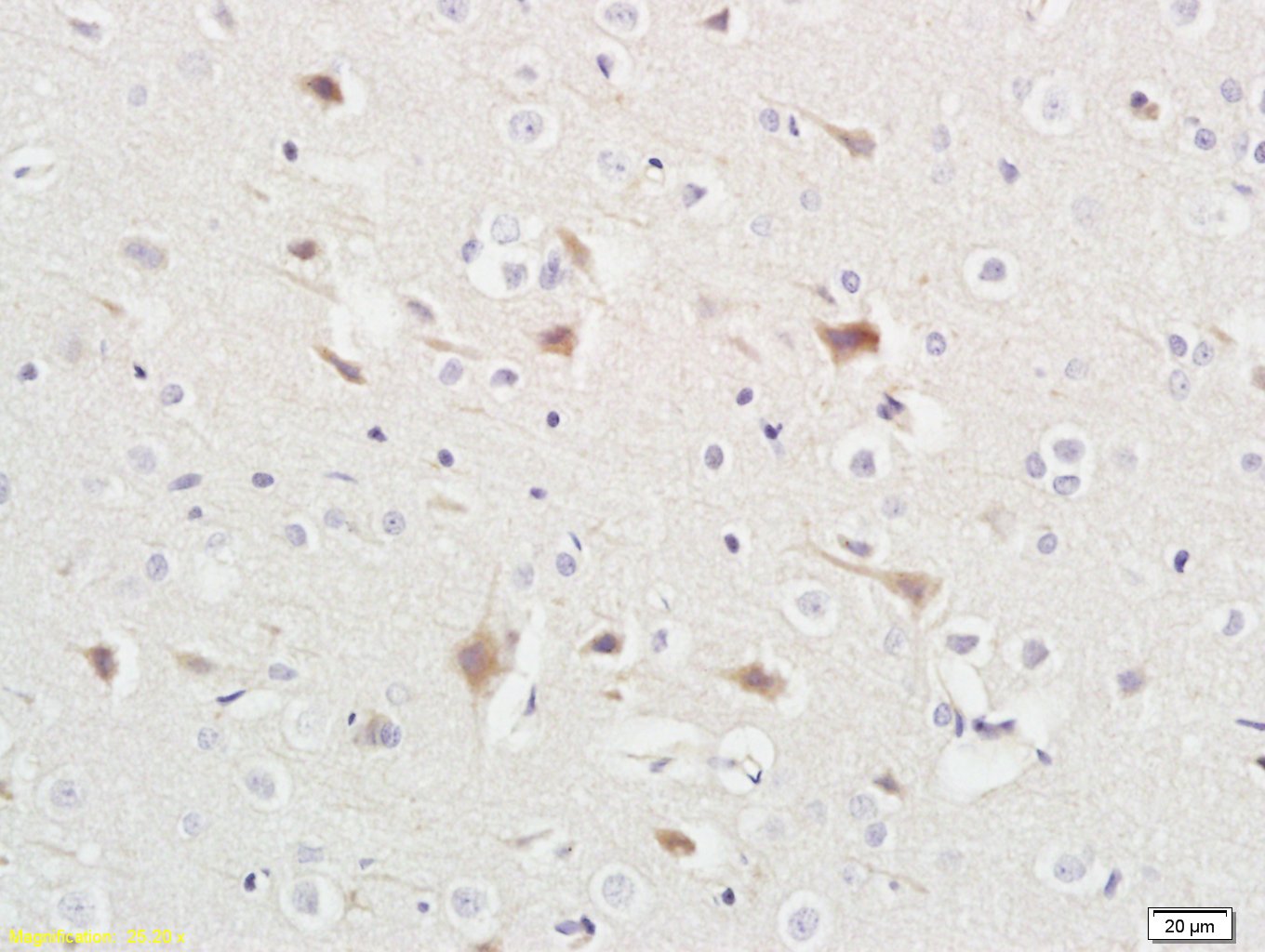ABHD5 Rabbit pAb
ABHD5 Rabbit pAb
- 产品详情
- 实验流程
- 背景知识
Application
| IHC-P, IHC-F, IF |
|---|---|
| Primary Accession | Q8WTS1 |
| Reactivity | Rat |
| Predicted | Human, Mouse, Dog, Rabbit, Sheep |
| Host | Rabbit |
| Clonality | Polyclonal |
| Calculated MW | 39096 Da |
| Physical State | Liquid |
| Immunogen | KLH conjugated synthetic peptide derived from human ADHD5 |
| Epitope Specificity | 281-349/349 |
| Isotype | IgG |
| Purity | affinity purified by Protein A |
| Buffer | 0.01M TBS (pH7.4) with 1% BSA, 0.02% Proclin300 and 50% Glycerol. |
| SUBCELLULAR LOCATION | Cytoplasm. Lipid droplet. |
| SIMILARITY | Belongs to the peptidase S33 family. ABHD4/ABHD5 subfamily. |
| SUBUNIT | Interacts with ADRP, PLIN and PNPLA2 (By similarity). |
| DISEASE | Defects in ABHD5 are the cause of Chanarin-Dorfman syndrome (CDS) [MIM:275630]; also called triglyceride storage disease with impaired long-chain fatty acid oxidation or neutral lipid storage disease with ichthyosis. CDS is an autosomal recessive inborn error of lipid metabolism with multisystemic accumulation of triglycerides although plasma concentrations are normal. Clinical characteristics are congenital generalized ichthyosis, vacuolated leukocytes, hepatomegaly, myopathy, cataracts, neurosensory hearing loss and developmental delay. The disorder presents at birth with generalized, fine, white scaling of the skin and a variable degree of erythema resembling non-bullous congenital ichthyosiform erythroderma. |
| Important Note | This product as supplied is intended for research use only, not for use in human, therapeutic or diagnostic applications. |
| Background Descriptions | Abhd5 belongs to a large family of proteins defined by an alpha/beta hydrolase fold, and contains three sequence motifs that correspond to a catalytic triad found in the esterase/lipase/thioesterase subfamily. It differs from other members of this subfamily in that its putative catalytic triad contains an asparagine instead of the serine residue. Mutations in this gene have been associated with Chanarin-Dorfman syndrome, a triglyceride storage disease with impaired long-chain fatty acid oxidation. Widely expressed in various tissues, including skin, lymphocytes, liver, skeletal muscle and brain. |
| Gene ID | 51099 |
|---|---|
| Other Names | 1-acylglycerol-3-phosphate O-acyltransferase ABHD5, 2.3.1.51, Abhydrolase domain-containing protein 5, Lipid droplet-binding protein CGI-58, ABHD5 (HGNC:21396), NCIE2 |
| Target/Specificity | Widely expressed in various tissues, including lymphocytes, liver, skeletal muscle and brain. Expressed by upper epidermal layers and dermal fibroblasts in skin, hepatocytes and neurons. |
| Dilution | IHC-P=1:100-500,IHC-F=1:100-500,IF=1:100-500 |
| Storage | Store at -20 °C for one year. Avoid repeated freeze/thaw cycles. When reconstituted in sterile pH 7.4 0.01M PBS or diluent of antibody the antibody is stable for at least two weeks at 2-4 °C. |
| Name | ABHD5 (HGNC:21396) |
|---|---|
| Synonyms | NCIE2 |
| Function | Coenzyme A-dependent lysophosphatidic acid acyltransferase that catalyzes the transfer of an acyl group on a lysophosphatidic acid (PubMed:18606822). Functions preferentially with 1-oleoyl- lysophosphatidic acid followed by 1-palmitoyl-lysophosphatidic acid, 1- stearoyl-lysophosphatidic acid and 1-arachidonoyl-lysophosphatidic acid as lipid acceptor. Functions preferentially with arachidonoyl-CoA followed by oleoyl-CoA as acyl group donors (By similarity). Functions in phosphatidic acid biosynthesis (PubMed:18606822). May regulate the cellular storage of triacylglycerol through activation of the phospholipase PNPLA2 (PubMed:16679289). Involved in keratinocyte differentiation (PubMed:18832586). Regulates lipid droplet fusion (By similarity). |
| Cellular Location | Cytoplasm. Lipid droplet {ECO:0000250|UniProtKB:Q9DBL9}. Cytoplasm, cytosol {ECO:0000250|UniProtKB:Q9DBL9}. Note=Colocalized with PLIN and ADRP on the surface of lipid droplets. The localization is dependent upon the metabolic status of the adipocytes and the activity of PKA (By similarity). |
| Tissue Location | Widely expressed in various tissues, including lymphocytes, liver, skeletal muscle and brain. Expressed by upper epidermal layers and dermal fibroblasts in skin, hepatocytes and neurons (at protein level). |
For Research Use Only. Not For Use In Diagnostic Procedures.
Provided below are standard protocols that you may find useful for product applications.
BACKGROUND
Abhd5 belongs to a large family of proteins defined by an alpha/beta hydrolase fold, and contains three sequence motifs that correspond to a catalytic triad found in the esterase/lipase/thioesterase subfamily. It differs from other members of this subfamily in that its putative catalytic triad contains an asparagine instead of the serine residue. Mutations in this gene have been associated with Chanarin-Dorfman syndrome, a triglyceride storage disease with impaired long-chain fatty acid oxidation. Widely expressed in various tissues, including skin, lymphocytes, liver, skeletal muscle and brain.
终于等到您。ABCEPTA(百远生物)抗体产品。
点击下方“我要评价 ”按钮提交您的反馈信息,您的反馈和评价是我们最宝贵的财富之一,
我们将在1-3个工作日内处理您的反馈信息。
如有疑问,联系:0512-88856768 tech-china@abcepta.com.























 癌症的基本特征包括细胞增殖、血管生成、迁移、凋亡逃避机制和细胞永生等。找到癌症发生过程中这些通路的关键标记物和对应的抗体用于检测至关重要。
癌症的基本特征包括细胞增殖、血管生成、迁移、凋亡逃避机制和细胞永生等。找到癌症发生过程中这些通路的关键标记物和对应的抗体用于检测至关重要。 为您推荐一个泛素化位点预测神器——泛素化分析工具,可以为您的蛋白的泛素化位点作出预测和评分。
为您推荐一个泛素化位点预测神器——泛素化分析工具,可以为您的蛋白的泛素化位点作出预测和评分。 细胞自噬受体图形绘图工具为你的蛋白的细胞受体结合位点作出预测和评分,识别结合到自噬通路中的蛋白是非常重要的,便于让我们理解自噬在正常生理、病理过程中的作用,如发育、细胞分化、神经退化性疾病、压力条件下、感染和癌症。
细胞自噬受体图形绘图工具为你的蛋白的细胞受体结合位点作出预测和评分,识别结合到自噬通路中的蛋白是非常重要的,便于让我们理解自噬在正常生理、病理过程中的作用,如发育、细胞分化、神经退化性疾病、压力条件下、感染和癌症。






